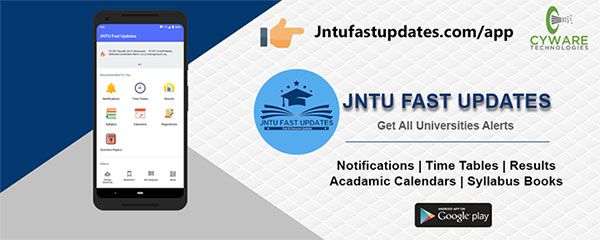JNTUK R20 2-1 STLD Material/Notes PDF Download
Students those who are studying JNTUK R19 ECE Branch, Can Download Unit wise R19 2-1 Switching Theory and Logic Design Material/Notes PDFs below.

JNTUK R20 2-1 STLD Material/Notes PDF Download
Course Objectives: This course is designed to:
- To solve a typical number base conversion and analyze new error coding techniques.
- Theorems and functions of Boolean algebra and behavior of logic gates.
- To optimize logic gates for digital circuits using various techniques.
- Boolean function simplification using Karnaugh maps and Quine-McCluskey methods.
- To understand concepts of combinational circuits.
- To develop advanced sequential circuits.
UNIT-1
REVIEW OF NUMBER SYSTEMS & CODES: Representation of numbers of different radix, conversation from one radix to another radix, r-1’s compliments and r’s compliments of signed members.Gray code ,4 bit codes; BCD, Excess-3, 2421, 84-2-1 code etc. Error detection & correction codes: parity checking, even parity, odd parity, Hamming code.
BOOLEAN THEOREMS AND LOGIC OPERATIONS: Boolean theorems, principle of complementation & duality, De-morgan theorems.Logic operations ; Basic logic operations -NOT, OR, AND, Universal Logic operations, EX-OR, EXNOR operations.Standard SOP and POS Forms, NAND-NAND and NOR-NOR realizations, Realization of three level logic circuits. Study the pin diagram and obtain truth table for the following relevant ICs 7400,7402,7404,7408,7432,7486.
Download UNIT-1 Material PDF | Reference-2 | Ref-3
UNIT-2
MINIMIZATION TECHNIQUES: Minimization and realization of switching functions using Boolean theorems, K-Map (up to 6 variables)and tabular method(Quine-mccluskey method) with only four variables and single function.
COMBINATIONAL LOGIC CIRCUITS DESIGN: Design of Half adder, full adder, half subtractor, full subtractor, applications of full adders; 4-bit adder-subtractor circuit, BCD adder circuit, Excess 3 adder circuit and carry look-a-head adder circuit, Design code converts using Karnaugh method and draw the complete circuit diagrams.
UNIT-3
COMBINATIONAL LOGIC CIRCUITS DESIGN USING MSI &LSI : Design of encoder, decoder, multiplexer and de-multiplexers, Implementation of higher order circuits using lower order circuits. Realization of Boolean functions using decoders and multiplexers.Design of Priority encoder, 4-bit digital comparator and seven segment decoder. . Study the relevant ICs pin diagrams and their functions 7442, 7447, 7485, 74154.
INTRODUCTION OF PLD’s : PLDs:PROM, PAL, PLA -Basics structures, realization of Boolean functions, Programming table.
Download UNIT-3 Material PDF | Reference-2
UNIT-4
SEQUENTIAL CIRCUITS I: Classification of sequential circuits (synchronous and asynchronous) , operation of NAND & NOR Latches and flip-flops; truth tables and excitation tables of RS flip-flop, JK flip-flop, T flip-flop, D flip-flop with reset and clear terminals. Conversion from one flip-flop toanother flipflop. Design of 5ripple counters, design of synchronous counters, Johnson counter, ring counter. Design of registers – Buffer register, control buffer register, shift register, bi-directional shift register, universal shift, register.
Study the following relevant ICs and their relevant functions 7474, 7475, 7476, 7490, 7493, 74121.
Download UNIT-4 Material PDF | Reference-2
UNIT-5
SEQUENTIAL CIRCUITS II: Finite state machine; state diagrams, state tables, reduction of state tables.Analysis of clocked sequential circuits Mealy to Moore conversion and vice-versa.Realization of sequence generator,Design of Clocked Sequential Circuit to detect the given sequence (with overlapping or without over lapping).
Download UNIT-5 Material PDF | Reference-2
Text Books:
- Switching and finite automata theory Zvi.KOHAVI, Niraj.K.Jha 3 rdEdition, Cambridge University Press, 2009
- Digital Design by M.MorrisMano, Michael D Ciletti,4th edition PHIpublication,2008
- Switching theory and logic design by Hill and Peterson, Mc-Graw Hill TMH edition, 2012.
Reference Books:
- Fundamentalsof Logic Design by Charles H. Roth Jr, JaicoPublishers, 2006
- Digital electronics by R S Sedha.S.Chand & company limited, 2010
- Switching Theory and Logic Design by A. AnandKumar,PHI Learning pvtltd, 2016.
- Digital logic applications and design by John M Yarbough, Cengage learning, 2006.
- TTL 74-Series databook.
Course Outcomes:
- Classify different number systems and apply to generate variouscodes.
- Use the concept of Boolean algebra in minimization of switchingfunctions
- Design different types of combinational logiccircuits.
- Apply knowledge of flip-flops in designing of Registers andcounters
- The operation and design methodology for synchronous sequential circuits and algorithmic statemachines.
- Produce innovative designs by modifying the traditional designtechniques.

320-x100(1).gif)

I want stld PDFs
Stld materials
Pdf of STLD
I want 2-1 ece stld lab manual
could you provide the important topics in Every unit in All subjects
hello sir